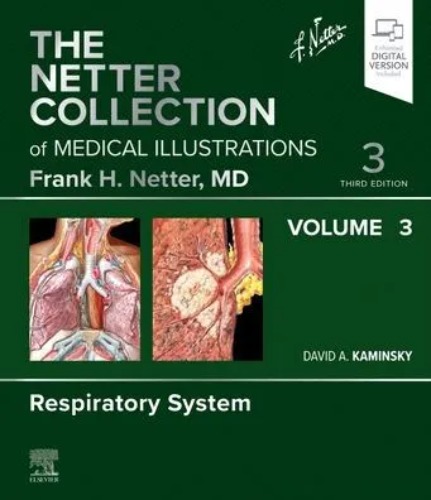상품상세정보
의학서적전문 "성보의학서적"의 신간도서입니다.
Offering a concise, highly visual approach to the basic science and clinical pathology of the respiratory system, this updated volume in The Netter Collection of Medical Illustrations (the CIBA "Green Books") contains unparalleled didactic illustrations reflecting the latest medical knowledge. Revised by Dr. David A. Kaminsky, Respiratory System, Volume 3 integrates core concepts of anatomy, physiology, and other basic sciences with common clinical correlates across health, medical, and surgical disciplines. Classic Netter art, updated and new illustrations, and modern imaging continue to bring medical concepts to life and make this timeless work an essential resource for students, clinicians, and educators.
Provides a complete overview of the respiratory system through multidisciplinary coverage from physiology and biochemistry to adult and pediatric medicine and surgery.
Allows you to access rare illustrations in one convenient source from the only Netter work devoted specifically to the respiratory system.
Covers timely topics like COVID-19 and secondary infection/diseases of the respiratory system, RSV, pneumonia, pulmonary hypertension, COPD, asthma, environmental lung disease, sleep disorders, infections of the immunocompromised, neonatal breathing disorders, and drug-resistant tuberculosis.
Provides a concise overview of complex information by seamlessly integrating anatomical and physiological concepts using practical clinical scenarios.
Shares the expertise and knowledge of editor Dr. David A. Kaminsky, who contributes significant experience in asthma and general pulmonary and critical care medicine, and a team of world-class contributors.
Compiles Dr. Frank H. Netter’s master medical artistry—an aesthetic tribute and source of inspiration for medical professionals for over half a century—along with new art in the Netter tradition for each of the major body systems, making this volume a powerful and memorable tool for building foundational knowledge and educating patients or staff.
NEW! An eBook version is included with purchase. The eBook allows you to access all of the text, figures, and references, with the ability to search, make notes and highlights, and have content read aloud.
-도서목차-
Section 1 Anatomy and Embryology
1-1 Respiratory System
Bony Thorax
Rib Characteristics and Costovertebral Articulations
Anterior Thoracic Wall
Anterior Thoracic Wall (Continued)
Anterior Thoracic Wall: Internal View
Dorsal Aspect of Thorax
Dorsal Aspect of Thorax: Posterior and Lateral Views
Course and Relations of Intercostal Nerves and Arteries
Diaphragm: Viewed from Above
Topography of Lungs: Anterior View
Topography of Lungs: Posterior View
Medial Surface of Lungs
Bronchopulmonary Segments
Bronchopulmonary Segments in Relationship to Ribs
Relations of Trachea and Main Bronchi
Bronchial Arteries
Mediastinum: Right Lateral View
Mediastinum: Left Lateral View
Innervation of Lungs and Tracheobronchial Tree
Structure of Trachea and Major Bronchi
Intrapulmonary Airways
Structure of Bronchi and Bronchioles – Light Microscopy
Ultrastructure of Tracheal, Bronchial, and Bronchiolar Epithelium
Bronchial Submucosal Glands
Intrapulmonary Blood Circulation
Fine Structure of Alveolar Capillary Unit: Ultrastructure of Pulmonary Alveoli and Capillaries
Fine Structure of Alveolar Capillary Unit (Continued): Type II Alveolar Cell and Surface-Active Layer
Fine Structure of Alveolar Capillary Unit (Continued): Pulmonary Vascular Endothelium
Lymphatic Drainage of the Lungs and Pleura
Lymphatic Drainage of the Lungs and Pleura: Distribution of Lymphatics
1-32 Pulmonary Immunology; Lymphocytes, Mast cells, Eosinophils, Neutrophils
Development of Lower Respiratory System
1-33 Developing Respiratory Tract and Pharynx
1-34 Respiratory System at 5 to 6 Weeks
1-35 Respiratory System At 6 to 7 Weeks
1-36 Larynx, Traceobronchial Tree, and Lungs at 7 to 10 Weeks
1-37 Sagittal Section At 6 to 7 Weeks
1-38 Transverse Section At 5 to 8 Weeks
1-39 Diaphragm at 5 to 6 Weeks
1-40 Terminal Air Tube
1-41 Alveolar-Capillary Relationships At Age 8 Years
1-42 Surfactant Effects
1-43 Physiology of the Perinatal Pulmonary Circulation
Section 2
Physiology Pulmonary Mechanics and Gas Exchange
Muscles of Respiration
Spirometry: Lung Volume and Measurement
Determination of Functional Residual Capacity (FRC)
Forces During Quiet Breathing
Measurement of Elastic Properties of Lung
Surface Forces In Lung
Elastic Properties of Respiratory System: Lung and Chest Wall
Distribution of Airway Resistance
Patterns of Airflow
Expiratory Flow
Forced Expiratory Vital Capacity Maneuver
Work of Breathing
Pleural Pressure Gradient and Closing Volume
Distribution of Pulmonary Blood Flow
Pulmonary Vascular Resistance
Pathways and Transfers of O2 and CO2
Blood Gas Relationships During Normal Ventilation and Alveolar Hypoventilation
Ventilation – Perfusion Relationships
Shunts
Oxygen Transport
Role of Lungs and Kidneys in Regulation of Acid-Base Balance
Response to Oxidant Injury
Lung Metabolism
2-23 Inactivation of Circulating Vasoactive Substances
2-24 Activation of Circulating Precursors of Vasoactive Substances
Control and Disorders of Respiration
2-25 Chemical Control of Respiration (Feedback Mechanism)
2-26 Neural Control of Breathing
2-27 Respiraotry Response to Exercise
2-28 Effects of High Altitude on Respiraotry Mechanism
2-29 Hyperventilation and Hypoventilation
2-30 Periodic Breathing (Cheyne-Stokes)
2-31 Sites of Pathologic Disturbances in Control of Breathing
Section 3
Diagnostic Procedures
3-1 – 3-3 Tests of Pulmonary Function
Radiologic Examination of the Lungs
3-4 Normal Posterior-Anterior (PA) and Lateral Views of Chest
3-5 Lateral Decubitus View
3-6 Technique of Helical Computerized Tomography (CT)
3-7 Right Bronchial Tree as Revealed by Bronchograms
3-8 Left Bronchial Tree as Revealed by Bronchograms
3-9 Pulmonary Angiography
3-10 Images from a PET-CT Scanner
3-11 Patterns of Lobar Collapse: Right Lung (After Lubert and Krause)
3-12 Patterns of Lobar Collapse: Left Lung (After Lubert and Krause)
3-13 Aveolar Versus Interstitial Disease
3-14 Distribution of Pulmonary Nodules
3-15 Aveolar Disease
3-16 Radiograph Consolidation Patterns of Each Segment of Lungs (AP Views)
3-17 Solitary Pulmonary Nodule
3-18 Airway and Pleural Diseases
3-19 Abnormalities of the chest Wall and Mediastinum
3-20 Exhaled breath analysis
Endoscopic Procedures
3-21 Flexible Bronchoscopy
3-22 Bronchoscopic Views
3-23 Nomenclature for Peripheral Bronchi
3-24 Rigid Bronchoscopy
3-25 Endobronchial Ultrasound
3-26 Mediastinotomy and Mediastinoscopy
Section 4
Diseases and Pathology Congenital Lung Disease
4-1 Congenital Deformities of Thoracic Cage
4-2 Pathology of Kyphoscoliosis
4-3 Pulmonary Function in Kyphoscoliosis
4-4 Congenital Diaphragmatic Hernia
4-5 Tracheoesophageal Fistulas and Tracheal Anomalies
4-6 Pulmonary Agenesis, Aplasia and Hypoplasia
4-7 Congenital lung cysts
4-8 Pulmonary Sequestration
4-9 Congenital Lobar Emphysema
4-10 Chronic Cough
Laryngeal Disorders
4-11 Common Laryngeal Lesions
4-12 Laryngeal Granuloma and Tracheal Stenosis
4-13 Vocal Cord Dysfunctions
Bronchial Asthma
4-14 Allergic Asthma: Clinical Features
4-15 Non-Allergic Asthma: Clinical Features
4-16 Common Precipitating Factors in Etiology of Bronchial Asthma
4-17 Variable Airflow Obstruction and Airway Hyperresponsiveness
4-18 Sputum in Bronchial Asthma
4-19 Skin Testing for Allergy
4-20 Representative Differential Diagnosis of Bronchial Asthma
4-21 Blood Gas and pH Relationships
4-22 Airway Pathophysiology in Asthma
4-23 Mechanism of Type 1 (Immediate) Hypersensitivity
4-24 Pathology of Severe Asthma
4-25 General Management Principles for Allergic Asthma
4-26 Mechanism of Asthma Medications
4-27 Emergency Department Management of Asthma
4-28 Interrelationship of Chronic Bronchitis and Emphysema
4-29 Emphysema
4-30 Chronic Bronchitis
4-31 Mixed Chronic Bronchitis and Emphysema
4-32 Cor Pulmonale Due To COPD
4-33 Chronic Obstructive Pulomary Disease
4-34 Anatomic Distribution of Emphysema
4-35 Centriacinar (Centrilobular) Emphysema
4-36 Panacinar (Panlobular) Emphysema
4-37 COPD: Inflammation
4-38 COPD: Protease-Antiprotease Imbalances
4-39 Pulmonary Function in Obstructive Disease
4-40 Pathophysiology of Emphysema
4-41 High Resolution CT Scan of Lungs in COPD
4-42 Summary of COPD Treatment Guidelines
Bronchiectasis
4-43 Bilateral Severe Bronchiectasis
4-44 Localized Bronchiectasis
Cystic Fibrosis
4-45 Pathophysiology and Clinical Manifestations of Cystic Fibrosis
4-46 Radiographic and Gross Anatomical Findings of the Lung Cystic Fibrosis
4-47 Cystic Fibrosis: Clinical Aspects
Lung Cancer Overview
4-48 Classification of Bronchogenic Carcinoma
4-49 Lung Cancer Staging
4-50 Squamous Cell Carcinoma of the Lung
4-51 Adenocarcinoma of the Lung
4-52 Large Cell Carcinomas of the Lung
4-53 Small Cell Carcinomas of the Lung
4-54 Superior Vena Cava Syndrome
4-55 Pancoast’s Tumor and Syndrome
Paraneoplastic Manifestations of Lung Cancer
4-56 Endocrine Manifestations of Lung Cancer
4-57 Neuromuscular and Connective Tissue Manifestations of Lung Cancer
4-58 Other Neoplasms of the Lung
4-59 Benign Tumors of Lung
4-60 Malignant Pleural Mesothelioma
4-61 Mediastinal Tumors: Anterior Mediastinum
4-62 Middle-Posterior and Paravertebral Mediastinum
4-63 Pulmonary Metastases
Pneumonia
4-64 Overview of Pneumonia
4-65 Pneumococcal Pneumonia
4-66 Pneumococcal Pneumonia (Continued)
Atypical Pathogen Pneumonia
4-67 Mycoplasmal Pneumonia
4-68 Chlamydophila Psittaci Pneumonia
4-69 Legionella Pneumonia
4-70 Staphylococcus Aureus Pneumonia
4-71 Hemophilus Influenzae Pneumonia
4-72 Gram –Negative Bacterial Pneumonia
Viral Community-Acquired Pneumonia
4-73 Influenza Virus and its Epidemiology
4-74 Influenzal Pneumonia
4-75 Varicella Pneumonia
4-76 Cytomegalovirus Penumonia
4-77 Severe Acute Respiratory Syndrome (SARS)
4-78 Lung Abscess
4-79 Lung Abscess (Continued)
4-80 Overviews of HCAP, HAP and VAP
4-81 Overviews of HCAP, HAP and VAP (Continued)
4-82 Pneumonia in the Compromised Host
4-83 Pneumonia in the Compromised Host (Continued)
4-84 Actinomycosis
4-85 Nocardiosis
4-86 Histoplasmosis
4-87 Histoplasmosis (Continued)
4-88 Coccidioidomycosis
4-89 Blastomycosis
4-90 Paracoccidioidomycosis
4-91 Cryptococcosis (Torulosis)
4-92 Aspergillosis
Tuberculosis
4-93 Dissemination of Tuberculosis
4-94 Evolution of Tubercle
4-95 Initial (Primary) Tuberculosis Complex
4-96 Progressive Pathology
4-97 Extensive Cavitary Disease
4-98 Miliary Tuberculosis
4-99 Tuberculin Testing
4-100 Sputum Examination
4-101 Sputum Culture
4-102 Nontuberculous Mycobacterial Lung Disease
Lung Diseases Caused by the Inhalation of Particles and Fumes
4-103 Overview of Inhalation Diseases
4-104 Silicosis
4-105 Silicosis (Continued)
4-106 Coal Worker’s Pneumoconiosis
4-107 Asbestosis and Asbestos-Related Diseases
4-108 Asbestosis and Asbestos-Related Diseases (Continued)
4-109 Beryllium
4-110 Pneumoconiosis Caused by Various Minerals and Mixed Dusts
4-111 Pneumoconiosis Caused by Various Minerals and Mixed Dusts (Continued)
4-112 Hypersensitivity Pneumonitis
4-113 Hypersensitivity Pneumonitis (Continued)
Pulmonary Embolism/Venous Thromboembolism
4-114 Predisposing Factors for Pulmonary Embolism
4-115 Sources of Pulmonary Emboli
4-116 Clinical Manifestations of Leg Vein Thrombosis
4-117 Ultrasound and CT in Diagnosis of Acute Venous Thromboembolism
4-118 Embolism of Lesser Degree without Infarction
4-119 Pulmonary Infarction
4-120 Massive Embolization
4-121 Mechanical Defenses Against and Chronic Effects of Pulmonary Embolism
4-122 Special Situations and Extravascular Sources of Pulmonary Emboli
Pulmonary Hypertension
4-123 WHO Classification System of Pulmonary Hypertension
4-124 Pathology of Pulmonary Hypertension
4-125 Diagnosis of Pulmonary Hypertension
4-126 Therapy for Pulmonary Hypertension
Pulmonary Edema
4-127 Pulmonary Edema: Pathway of Normal Pulmonary Fluid Resorption
4-128 Pulmonary Edema: Some Etiologies, and Hypotheses of Mechanisms
Pleural Effusion
4-129 Pathophysiology of Pleural Fluid Accumulation
4-130 Pleural Effusion in Heart Disease
4-131 Unexpandable Lung
4-132 Parapneumonic Effusion
4-133 Pleural Effusion in Malignancy
4-134 Chylothorax
Thoracic Trauma
4-135 Rib and Sternal Injuries
4-136 Flail Chest and Pulmonary Contusion
Pneumothorax
4-137 Tension Pneumothorax
4-138 Open (Sucking) Pneumothorax
4-139 Hemothorax
4-140 Pulmonary Laceration
4-141 Tracheobronchial Rupture
4-142 Traumatic Asphyxia
4-143 Diaphragmatic Injuries
Respiratory Distress Syndrome
4-144 Respiratory Distress Syndrome
4-145 Respiratory Distress Sydnrome (Continued)
4-146 Acute Lung Injury
Interstitial Lung Diseases
4-147 Idiopathic Interstitial Pneumonias
4-148 Idiopathic Interstitial Pneumonias (Continued)
4-149 Idiopathic Interstitial Pneumonias (Continued)
4-150 Cryoptogenic Organizing Pneumonia
4-151 Pulmonary Alveolar Proteinosis
4-152 Idiopathic Pulmonary Hemosiderosis
4-153 Lymphangioleiomyomatosis
4-154 Pulmonary Langerhans Cell Histiocytosis
4-155 Sarcoidosis
4-156 Sarcoidosis (Continued)
4-157 Rheumatoid Arthritis
4-158 Systemic Sclerosis (Scleroderma)
4-159 Systemic Lupus Erythematosus
4-160 Dermatomyositis and Polymyositis
4-161 Pulmonary Vasculitis
4-162 Eosinophilic Pneumonia
4-163 Pulmonary Manifestations of Other Diseases
4-164 Pulmonary Manifestations of Other Diseases (Continued)
4-165 Sleep Medicine
4-166 Sleep-Disordered Breathing
Section 5
Therapies and Therapeutic Procedures
Pulmonary Pharmacology
5-1 Bronchodilators
5-2 Methylxanthines
5-3 Methylxanthines: Adverse Effects
5-4 Anticholinergics
5-5 Corticosteroid Actions in Bronchial Asthma
5-6 Corticosteroids: Clinical Uses
5-7 Adverse Effects of Corticosteroids
5-8 Leukotrienes
5-9 Antileukotrienes
5-10 Cough Suppressants (Antitussive Agents)
5-11 Pulmonary Rehabilitation
Oxygen Therapy
5-12 Oxygen Therapy in Acute Respiratory Failure
5-13 Methods of Oxygen Administration
5-14 Oxygen Therapy in Chronic Respiratory Failure (Ambulatory and Home Use)
Airway Management
5-15 Introduction of Chest Drainage Tubes
5-16 Chest Draining Methods
5-17 Postural Drainage and Breathing Exercises
5-18 Upper Airway Obstruction and the Heimlich Maneuver
5-19 Securing an Emergent Airway
5-20 Endotracheal Intubation
5-21 Tracheostomy
5-22 Morbidity of Endotracheal Intubation and Tracheostomy
5-23 Endotracheal Suction
5-24 Mechanical Ventilation
Lung Surgery
5-25 Tracheal Resection and Anastomosis
5-26 Removal of Mediastinal Tumors
5-27 Sublobar Resection and Surgical Lung Biopsy
5-28 Lobectomy
5-29 Pneumonectomy
5-30 Pneumonectomy (Continued)
5-31 Video Assisted Thoracoscopic surgery (VATS)
5-32 Lung Volume Reduction Surgery (LVRS)
5-33 Lung Transplant
기타 도서와 관련된 문의사항은 고객센터(02-854-2738) 또는 저희 성보의학서적 홈페이지내 도서문의 게시판에 문의바랍니다.
감사합니다.
성보의학서적 "http://www.medcore.kr































